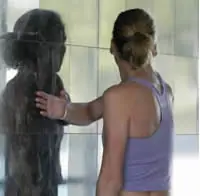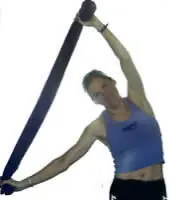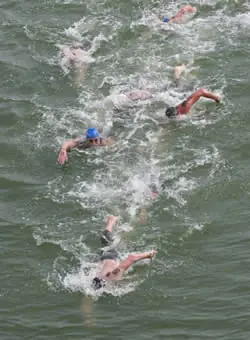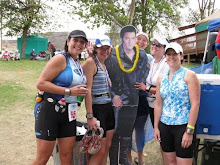From
Competitor * December 27, 2009
With the winter and holidays comes pool closures. Professional triathlete Sara McLarty has some dry land swim workouts to try out when you can’t get in your local pool.
Written by: Sara McLarty
The National Training Center pool, in Clermont, Fla., was closed on Labor Day for both the holiday and for maintenance. The swimmers were unaware of the undertaking until we arrived for swim practice on Tuesday and peered down into a half-filled pool. This meant we had spent a total of three days out of the water since our last practice on Saturday morning. Getting a balanced number of practices is very important for multisport athletes, but I didn’t panic about this unplanned absence from the water. Instead, I used my knowledge and experience of swimming-specific strength training and got a great “swim practice” in the gym.
The following exercises are not just for days when you can’t swim in the pool. You will see improvement in the water just by including these strength-building and injury-prevention exercises into your regular gym session. It can be as easy as adding a swimming specific five to 10 minutes at the end of your regular strength routine. By staying ahead of the curve with overused joints and muscles, you can reduce the chance of being sidelined for a sore shoulder or another malady.
I perform all of these exercises during my gym sessions three times each week.
Shoulder strength is very important because I have dislocated my shoulders multiple times during my swimming career. Keeping all those little muscles strong is critical to preventing another trip to the emergency room. When I am traveling, I try to stay on top of the easier things, like core strength.
AbsAll of your power in the water comes from core strength. The kick starts at your hip flexors and gluteus while your arm stroke uses lats (latissimus dorsi), upper back and pectorals. Strong abdominal and oblique muscles are critical for good hip and body rotation through the water. There are some swimming-specific core exercises that can be mixed in with other crunches and sit-ups.
Supermans are performed by lying flat on your stomach with your arms stretched out over your head. Slowly lift your legs, head and arms. Pause about six inches off the ground (you should look like Superman in-flight) and then slowly lower everything. Pause again before repeating. Do two to three sets of 10 to 15 lifts. You should feel this in your lower back.
Side crunches are often overlooked. My favorite exercise is performed on a medicine ball by lying on my side and bracing my feet against the bottom of a wall. First, I lock my hands behind my head, face completely sideways, and crunch my top elbow toward the wall. After just 20 reps, I switch to the other side, sometimes pausing in the middle to perform a quick set of regular medicine ball crunches. Do two to three sets of 15 reps on each side.
Plank hold is a stability exercise for your whole core. The proper position looks a little like push-up-position by balancing on your toes with a strong, flat back. Keep both forearms on the ground; they should form a triangle under your face, with hands clasped under your forehead. Use a stopwatch or the second hand on a wall clock and try to hold yourself up for 30 to 45 seconds. As your core becomes stronger, try for 60 to 75 seconds. Do two plank holds each session.
Flutter kicks are great for strengthening your hip flexors. If you ever do a long or hard kicking set in the pool, you should feel these little guys screaming afterward! These are the same muscles used in the up-pedal stroke on your bike. Lie on your back, with your hands under your butt cheeks for support. Lift your head and shoulders off the ground, look down towards your feet. Lift your legs 5 to 7 inches off the ground, point your toes and flutter kick (just like freestyle kick in the pool). I like to time this exercise, between 30 and 60 seconds, two sets per gym session.
ShouldersAs previously mentioned, my shoulders are something I never forget about in the gym. After years and years of the repetitive motion of freestyle, my ligaments are very loose. I use the following exercises to keep the containment muscles strong and prevent future injuries.
Three way is basically three similar exercises combined into one session. Use small hand weights, between four and seven pounds. Start by holding the weights at your sides and perform all lifts with straight arms to shoulder height. First, lift your arms out to the sides (90 degrees), palms down. Lower slowly. Then, lift your arms in front of you, shoulder width apart (10 degrees), with palms facing each other. Lower slowly. Finally, lift your arms at 45 degrees, palms facing away from each other. Lower slowly. Do two sets of 12 to 15 lifts.
Overhead press: With slightly heaver weights, between 10 and 15 pounds, perform two sets of 10 to 12 reps of this exercise. Because the position of your arms is very important, I recommend standing in front of a mirror. Start with the weights next to your head, palms facing the mirror, shoulders and elbows at 90 degrees. Press the weights straight up with extended arms and lower them slowly to the start position. Next rotate your shoulders around in front of your face (keep elbows at 90-degree angles), turn your palms toward your face, and tap the ends of the weights together. Return to the start position and repeat.
Up-out-in-down is pretty self-explanatory. Use medium to light dumbbells for this exercise (5 to 10 pounds) and start with your arms at your sides, palms facing your hips. Lift the dumbbells straight up in front of your body to shoulder height. Spread your arms out to the side of your body (keep them at shoulder height), bring them back in together and then lower them back down to your sides. Repeat this motion 10 times, rest, then do a second set.
Rowing is a great strength exercise to prevent “swimmer’s slouch.” Multisport athletes tend to swim a lot of freestyle, resulting in overdevelopment of the chest muscles. You can counter this slouch by working the trapezius muscles with a rowing machine or just some dumbbells and a bench. I prefer to use the rowing machine so I can focus on using my shoulder blades to pull the weight slowly, and release the weight slowly. Think about pinching your shoulder blades together each time. Do two sets of 10 to 12 reps.
If you have access to a swimming machine like a Vasa, IsoCircuit or Halo swim bench, then a day or two out of the pool is not a concern. These tools so closely mirror the swim stroke that your body will hardly know the difference. The worst consequences of being out of the pool for a few unplanned days: Your skin will stop smelling like chlorine during other training sessions (have you ever caught a whiff of your sweat on a post-swim practice run?) and your goggle tan might fade a bit (raccoon, anyone?).















































